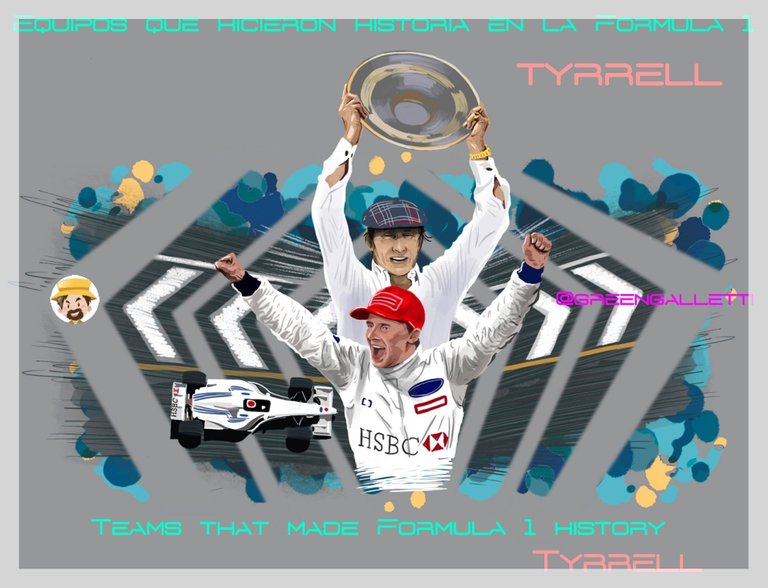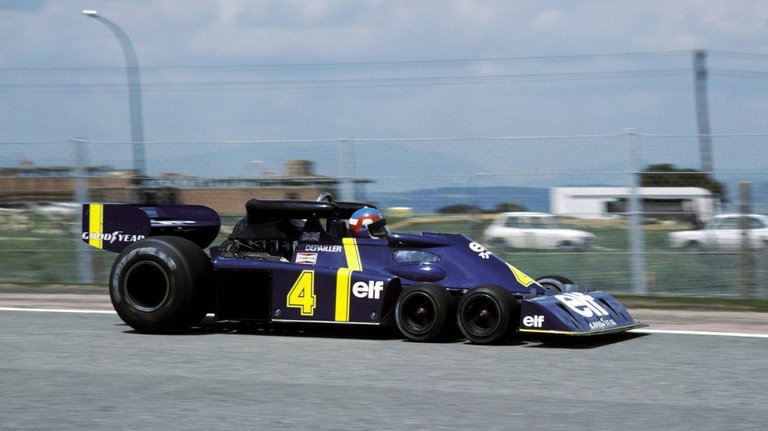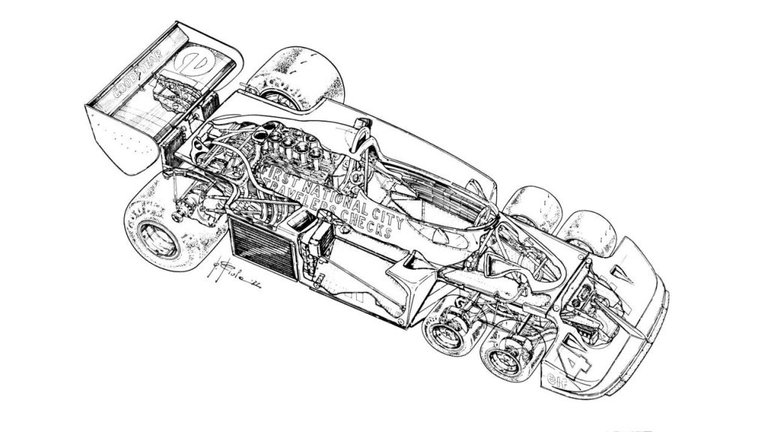[ESP/ENG] Equipos que hicieron historia en la Fórmula 1: Tyrrell y el inolvidable monoplaza con seis ruedas. / Teams that made Formula 1 history: Tyrrell and the unforgettable single-seater with six wheels.

Sigo compartiendo con los #hivers deportivos de esta Comunidad, especialmente para aquellos apasionados de la Fórmula 1 la historia de equipos, hoy en el olvido, que han hecho parte importante en la historia de la categoría.
Ya sea porque han pasado muchos años desde que han desaparecido de la Fórmula 1 o ya sea porque la mayor parte de los usuarios de estas plataformas de contenidos son personas jóvenes y en ese momento algunos ni siquiera habían nacido mientras otros eran apenas niños o adolescentes, lo cierto es que merecen ser rescatados del olvido.
Por la contribución que dieron a la máxima categoría del automovilismo deportivo con su nombre, por su trayectoria en la misma y, muchas veces, por los triunfos y campeonatos logrados.
En el primer post dedicado a estos equipos en @fulldeportes les hablé de Lotus, el mítico equipo de los colores negro y dorado (los colores de una famosa tabacalera de los años ochenta antes de que se desatara la campaña mundial de lucha contra el cáncer y la prohibición de las tabacaleras promocionaran espectáculos deportivos y cualquier otro tipo de evento, obligándoles a poner en cada paquete de cigarrillos leyendas advirtiendo del peligro mortal que comporta fumar con asiduidad).
El equipo dirigido por Colin Chapman, el manager cuya muerte es aún hoy, es un misterio, que tenía la costumbre de tirar la goma que usaba siempre cuando uno de sus monoplazas conseguía la victoria, propia al pasar la línea de meta.
Hoy les voy a hablar de otro equipo legendario, aunque tal vez con menos laureles que Lotus, pero que tuvo el gran mérito de promover dentro de la Fórmula a pilotos del calibre de Jody Scheckter, Jean Alesi, Patrick Depailler, Didier Pironi y Michele Alboreto y Jackie Stewart (quien le dio en 1971 y 1973 los dos únicos campeonatos mundiales de pilotos obtenidos) algunos de ellos a la postre campeones mundiales con otros equipos.
Se trata de Tyrrel, el equipo creado por Ken Tyrrell en el año 1971, uno de los personajes más excéntricos y carismáticos de la historia del automovilismo y que en su momento fue la sensación de la F1 con el famoso y peculiar Tyrrell P34, con 6 ruedas, el único de su tipo que ha competido en toda la historia de la Fórmula 1. Y hasta llegó a ganar un Gran Premio.

I continue to share with the #sportshivers of this Community, especially for those passionate about Formula 1, the history of teams, today forgotten, that have played an important part in the history of the category.
Either because many years have passed since they have disappeared from Formula 1 or because most of the users of these content platforms are young people and at that time some of them were not even born while others were just children or teenagers, the truth is that they deserve to be rescued from oblivion.
For the contribution they made to the maximum category of motorsport with their name, for their trajectory in it and, many times, for the triumphs and championships achieved.
In the first post dedicated to these teams in @fulldeportes I told you about Lotus, the mythical team of the black and gold colors (the colors of a famous tobacco company in the eighties before the worldwide campaign against cancer was unleashed and the prohibition of tobacco companies to promote sporting events and any other type of event, forcing them to put legends on every pack of cigarettes warning of the deadly dangers of regular smoking).
The team led by Colin Chapman, the manager whose death is still a mystery today, had the habit of throwing away the rubber he always used when one of his single-seaters got the victory, even when passing the finish line.
Today I am going to talk about another legendary team, although perhaps with less laurels than Lotus, but which had the great merit of promoting drivers of the caliber of Jody Scheckter, Jean Alesi, Patrick Depailler, Didier Pironi and Michele Alboreto and Jackie Stewart (who gave it in 1971 and 1973 the only two world championships of drivers obtained), some of them later world champions with other teams.
This is Tyrrel, the team created by Ken Tyrrell in 1971, one of the most eccentric and charismatic characters in the history of motor racing and that at the time was the sensation of F1 with the famous and peculiar Tyrrell P34, with 6 wheels, the only one of its kind that has competed in the history of Formula 1. And he even won a Grand Prix.
Entre fantasía y realidad, el mito inolvidable de las seis ruedas.

La experiencia de Tyrrell en la F1 comienza bajo el nombre de Matra y asociados a Ford para la provisión de los motores Cosworth. Gracias a esta alianza gana con Jackie Stewart el Campeonato de Fórmula 1 con vehículos Matra-Ford en 1970.
Es un año más tarde, en 1971, cuando Tyrrell decide de fundar su propio equipo, produce su primer vehículo y gana el campeonato de pilotos y de constructores, con los pilotos Jackie Stewart y François Cévert.
La historia de sucesos y buenas performances continúa y en 1973 ambos pilotos terminan en el primer y segundo lugar, pero a fines de la temporada François Cévert muere en un accidente durante las prácticas en el Gran Premio de los Estados Unidos. Tal vez por ese motivo y por la imposibilidad de seguir luchando por el título, Jackie Stewart abandona el equipo.
De ahí en más, el equipo nunca volvería a ganar un título mundial.
Los resultados intermedios obtenidos hasta 1976 lo llevaron a experimentar una novedad absoluta que nunca había intentado otro equipo en la F1: montar un monoplaza con seis ruedas.
A pesar de la poca confianza que críticos especializados y colegas depositaron en él, el monoplaza Tyrrell P34 logró una victoria en el Gran Premio de Suecia, aunque ya la curva ascendente en su rendimiento había comenzado a manifestarse a partir del GR de Mónaco cuando Scheckter y Depailler fueron segundo y tercero por detrás del Ferrari de Niki Lauda.
El punto culminante de esta nueva y revolucionaria experiencia fue en el circuito sueco Anderstorp, donde, en la cuarta carrera del coche, el sudafricano Scheckter consiguió la pole y junto al francés Depailler hicieron un doblete que quedara en la historia de la Fórmula 1.
El objetivo de Tyrrell era reducir el área frontal del monoplaza, eliminando gran parte de la resistencia aerodinámica y ganar velocidad punta.
A pesar de los resultados favorables al inicio, su aventura en las pistas de la Fórmula 1 fue bastante corta: apenas 30 carreras.

Tyrrell's F1 experience begins under the name of Matra and associated with Ford for the supply of Cosworth engines. Thanks to this alliance, Tyrrell wins the Formula 1 Championship with Jackie Stewart in 1970 with Matra-Ford vehicles.
A year later, in 1971, Tyrrell decided to found its own team, produced its first car and won the drivers' and constructors' championship with drivers Jackie Stewart and François Cévert.
The story of events and good performances continues and in 1973 both drivers finish in first and second place, but at the end of the season François Cévert dies in an accident during practice at the United States Grand Prix. Perhaps for that reason and because of the impossibility to continue fighting for the title, Jackie Stewart leaves the team.
From then on, the team would never win a world title again.
The intermediate results obtained until 1976 led the team to experiment an absolute novelty that had never been attempted by any other F1 team: to build a single-seater with six wheels.
Despite the little confidence that specialized critics and colleagues placed in it, the Tyrrell P34 car achieved a victory in the Swedish Grand Prix, although the upward curve in its performance had already begun to manifest itself from the Monaco GR when Scheckter and Depailler were second and third behind Niki Lauda's Ferrari.
The highlight of this new and revolutionary experience was at the Swedish Anderstorp circuit, where, in the fourth race of the car, the South African Scheckter took pole position and together with the Frenchman Depailler made a double that would go down in the history of Formula 1.
Tyrrell's goal was to reduce the frontal area of the car, eliminating much of the aerodynamic drag and gaining top speed.
Despite the favorable results at the beginning, its adventure on Formula 1 tracks was quite short: only 30 races.
Escándalo, violación del reglamento y expulsión. /Scandal, violation of regulations and expulsion.

El período más negro vivido por Tyrrell fue en el año 1984, cuando la FIA descubre que ha estado violando el reglamento haciendo correr un monoplaza con un peso inferior al permitido, lo que queda caratulado como fraude deportivo, el equipo es expulsado del campeonato de Fórmula 1 y todos sus resultados (es decir los puntos) de esa temporada fueron anulados.
El fraude fue descubierto el 24 de junio de 1984 durante el Gran Premio de los Estados Unidos celebrado en Detroit. Evidentemente la carrera en suelo estadounidense le ha traído en más de una oportunidad amargos recuerdos a Ken Tyrrell.
¿En qué consistía específicamente el fraude para aligerar el peso de los monoplazas y pasar inobservados? Bastante simple e ingenioso. Introducían pequeñas bolas de plomo mezcladas con el combustible -en la última parada en boxes- lo que permitía a la hora de verificar el peso de los autos al final de la carrera de cumplir con el reglamento y alcanzar el peso mínimo requerido.
Les quiero recordar que, en esa época, el reglamento era distinto, y en cada parada en boxes se podían cambiar los neumáticos y agregar combustible.
La penalización quedó sin efecto para el año siguiente, 1985, cuando Tyrrell pudo volver a competir, con la advertencia que si volvía a repetir una acción dolosa similar sería excluido de por vida en las competencias de la F1.
Pero el daño a nivel económico y de imagen había sido demasiado grande y el equipo nunca pudo recuperarse del todo.
Continuó participando con irregulares resultados durante toda la década del noventa hasta que en 1998 fue adquirido por la multinacional British American Tobacco, desapareciendo la marca de un equipo que había animado por casi tres décadas las competencias de la Fórmula 1.
El equipo pasaría a la historia de la F1 con estas estadísticas: 2 campeonatos mundiales de pilotos con Jackie Stewart (1971 y 1973), 1 campeonato mundial de constructores (1971), 23 triunfos, incluyendo el obtenido con el monoplaza de seis ruedas, 14 pole position y 20 vueltas rápidas.
Ken Tyrrell se retira de toda actividad deportiva y muere en el 2001.
El nuevo equipo toma las iniciales de la empresa y pasa a llamarse BAR, que después fue vendido a Honda, quien luego de pocos años en F1 vende el equipo por el precio simbólico de 1 USD a Ross Brawn, que le cambió el nombre por Brawn GP, utilizando motores Mercedes-Benz ganando ambos mundiales en el primer año de competición -2009- vendiéndolo en el 2010 al actual Mercedes. El campeonato del 2009 también estuvo salpicado por el escándalo de los famosos deflectores que mejoraban las prestaciones del auto.
El equipo Brawn no pudo ser penalizado porque no contravenía los reglamentos de la FIA, ya que en ningún momento en sus normas se especificaba en que modo podían ser posicionados los deflectores. Los mismos que en la actual temporada están marcando el declino de Mercedes y la supremacía de Ferrari y Red Bull, ironía del destino, los mayores críticos de los deflectores en el 2009 y quienes más encarnizadamente lucharon para que la FIA penalizara la Brawn y le quitara los puntos.
Si tuviéramos que establecer un "árbol genealógico automovilístico" podríamos decir que el actual equipo Mercedes reconoce en Tyrrell uno de sus más ilustres antepasados, del cual directamente desciende.

The darkest period experienced by Tyrrell was in 1984, when the FIA discovered that it had been violating the regulations by running a single-seater with a lower weight than allowed, which was classified as sporting fraud, the team was expelled from the Formula 1 championship and all its results (i.e. points) for that season were annulled.
The fraud was discovered on June 24, 1984 during the United States Grand Prix held in Detroit. Evidently the race on US soil has more than once brought back bitter memories for Ken Tyrrell.
What specifically was the fraud to lighten the weight of the single-seaters and pass unobserved? Quite simple and ingenious. They introduced small balls of lead mixed with the fuel - in the last pit stop - which allowed at the time of checking the weight of the cars at the end of the race to comply with the regulations and reach the minimum weight required.
I would like to remind you that, at that time, the regulations were different, and at each pit stop tires could be changed and fuel could be added.
The penalty was waived for the following year, 1985, when Tyrrell was allowed to race again, with the warning that if he repeated a similar malicious action he would be banned for life from F1 racing.
But the financial and image damage had been too great and the team was never able to fully recover.
It continued to participate with irregular results throughout the nineties until 1998, when it was acquired by the multinational British American Tobacco, thus disappearing the brand of a team that had animated Formula 1 competitions for almost three decades.
The team would go down in F1 history with these statistics: 2 drivers' world championships with Jackie Stewart (1971 and 1973), 1 constructors' world championship (1971), 23 victories, including the one obtained with the six-wheel single-seater, 14 pole positions and 20 fastest laps.
Ken Tyrrell retires from all sporting activity and dies in 2001.
The new team took the initials of the company and was renamed BAR, which was later sold to Honda, who after a few years in F1 sold the team for the symbolic price of 1 USD to Ross Brawn, who changed the name to Brawn GP, using Mercedes-Benz engines, winning both world championships in the first year of competition -2009- and sold it in 2010 to the current Mercedes. The 2009 championship was also marked by the scandal of the famous deflectors that improved the car's performance.
The Brawn team could not be penalized because it did not contravene the FIA regulations, since at no time in its rules was it specified in which way the deflectors could be positioned. The same that in the current season are marking the decline of Mercedes and the supremacy of Ferrari and Red Bull, irony of fate, the biggest critics of the deflectors in 2009 and who most fiercely fought for the FIA to penalize Brawn and take away the points.
If we were to establish an "automotive family tree" we could say that the current Mercedes team recognizes in Tyrrell one of its most illustrious ancestors, from which it directly descends.
Hasta nuestro próximo encuentro recordando los equipos (hoy ausentes) que han hecho parte de la historia de la Fórmula 1.
Until our next meeting remembering the teams (today absent) that have been part of the history of Formula 1.


La parte inferior del banner de la firma corresponde al badget elaborado por el equipo de @hivebuzz. Mi agradecimiento a ellos y en particular a @arcange.
The lower part of the signature banner corresponds to the badget made by the @hivebuzz team. My thanks to them and in particular to @arcange.
El separador de párrafos es propiedad de The Peak Studio a quien agradezco la gentil concesión de uso.
The paragraph separator is the property of The Peak Studio to whom I am grateful for the kind permission to use it.
Traducido con / Translated with: DeepL Translator.
https://twitter.com/HugoRep/status/1521919429856174082
The rewards earned on this comment will go directly to the person sharing the post on Twitter as long as they are registered with @poshtoken. Sign up at https://hiveposh.com.
Thank you for the tokens received and for sharing my content @poshtoken.
Congratulations @greengalletti! You have completed the following achievement on the Hive blockchain and have been rewarded with new badge(s):
Your next target is to reach 2000 comments.
You can view your badges on your board and compare yourself to others in the Ranking
If you no longer want to receive notifications, reply to this comment with the word
STOPTo support your work, I also upvoted your post!
Check out the last post from @hivebuzz:
Support the HiveBuzz project. Vote for our proposal!
Thank you for your continued support @hivebuzz.
Never knew such history.
Thanks for sharing. 🙂
!1UP
Thank you for curating my content @thecuriousfool.
My pleasure. I've gained new information because of it. 🙂
You have received a 1UP from @thecuriousfool!
@sports-curatorAnd they will bring !PIZZA 🍕
Learn more about our delegation service to earn daily rewards. Join the family on Discord.
Thanks @curation-cartel!